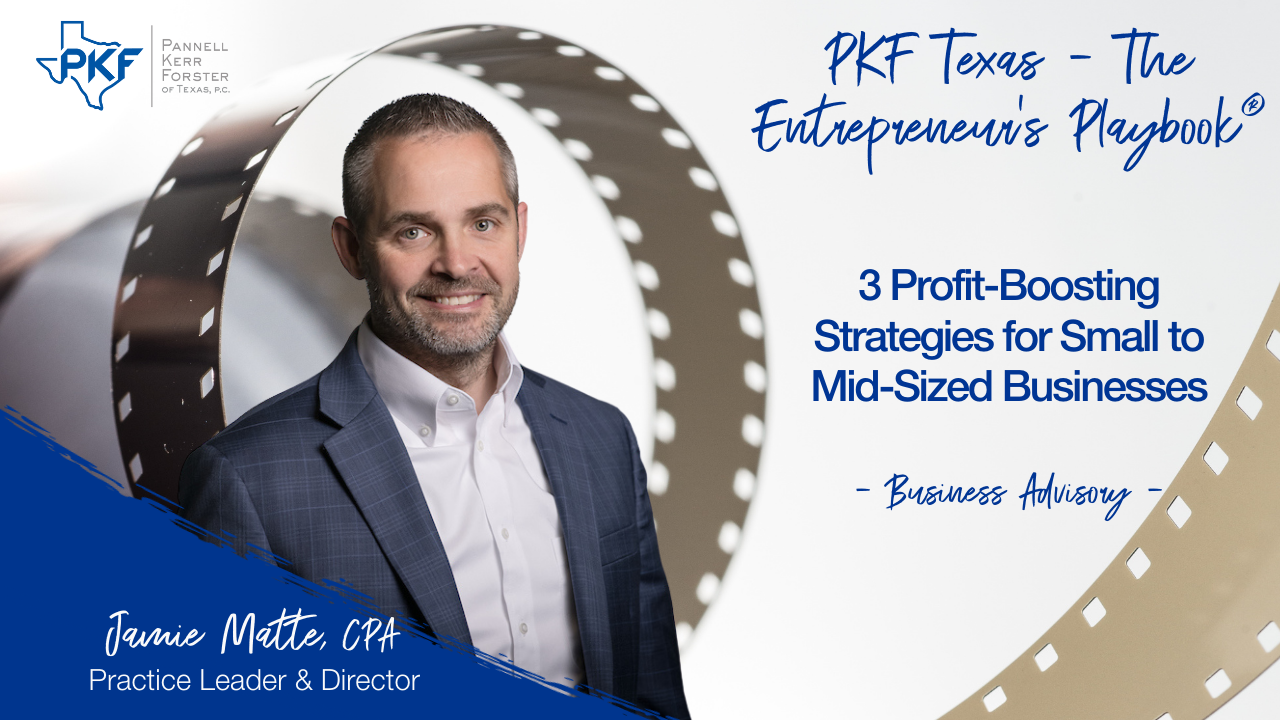3 Profit-Boosting Strategies for Small to Mid-Sized Businesses

In this PKF Texas – Entrepreneurs Playbook® episode, Jen Lemanski sits with Jamie Matte, CPA, Business Advisory Director and one of our Approachable Advisor®, to discuss practical profit enhancement strategies for small to mid-sized businesses.
Transcript Below
Jen: This is the PKF Texas – Entrepreneurs Playbook®. I’m Jen Lemanski and I’m here with Jamie Matte, a business advisory director and one of the Approachable Advisors® here at PKF Texas. Jamie, welcome to the Playbook.
Jamie: Yeah, good to be here, Jen.
Jen: So business advisory. I know you do a lot of, kind of more of the consulting with our clients and things. And I know a big thing is profit enhancement. So what are some recommendations that you have for small to medium sized businesses where they can enhance their profitability?
Jamie: So yeah, we do, we work with small to medium sized businesses. Right. And especially in these kind of economies, we’re always looking for enhancing our profitability. Right. So I kind of take a three prong approach. Right. So I don’t like to forget about the top line. So we look at revenue. Right. Then the second is looking at operational efficiencies and the third is probably the most common of what people think.
And that’s going to be cost and expense reductions. Right. So let me jump a little bit into each one of these. Right, sure. So, so from a revenue perspective, right. It’s looking at, it’s looking at your pricing strategy. Am I maximizing my products and my services or the value that I’m getting for my products and services out in the marketplace?
Another thing there is cross selling. Am I cross selling and offering my full line of products and services to the marketplace? Going to that second category, operational efficiencies. That’s how we deliver our products and services to the marketplace place. So that’s looking at things of process improvements where you can do time and motion studies, training, development of people to improve those processes and procedures.
And then like I said, the most common one that’s thought of is expense reductions and cost reductions. Right. And those you can do a variety of waste audits and build plans around those kind of things.
Jen: So cost savings, that seems like a pretty important one. What do you recommend businesses start with kind of first when they’re looking to down that path.
Jamie: Yeah, yeah. So again, this is one of those. Depending on the size of the company and the complexity of the company, there could be a number of areas. Right. So again, kind of three different areas. One’s going to be your recurring expenses. So think of things like subscriptions, telephone expenses, uniforms, those kind of things.
What we’re looking for is, you know, services that we are paying for that we may not even be using. Good example is I’m paying for 15 telephone lines, but I’m only using 10. Right. A lot of times we Just go on autopilot every year we just renew.
Jen: It and it just goes.
Jamie: That’s right. So it’s kind of doing an audit of those kind of things. And I think businesses, they’re usually surprised at the amount of waste that’s out there. Second category looks at your suppliers. Right. So those are looking at things like pricing of products and what the market rates are as well as looking for things like, like volume discounts and it’s considering negotiating or renegotiating contracts.
And what I like to encourage is finding win wins for both the suppliers and for the business to be able to save costs. The third one is looking at areas where you can potentially outsource in some cases in source. So things like it, payroll, those are common things that companies may be doing in house that may be more cost effective to bring those outside.
On the flip side and this often times in kind of operational areas where you may be, you may have outsourced and you have a large volume of business that’s going outsourced and you may be able to enhance your profit by bringing that in house.
Jen: Yeah. Hiring one person instead of paying that outsourced fee.
Jamie: That’s correct. That’s right. So yeah, those are kind of the areas of, you know what I consider the low hanging fruit that a lot of companies can kind of implement in and get kind of a bang for the buck as quickly as possible.
Jen: Now do you see any kind of do’s and don’ts across industries, across levels, that type of thing?
Jamie: Yeah, absolutely. So one of the key things is going to be make it collaborative, bring your management team in, bring your decision makers in, you get better buy in and success when you work at it from that angle. The other thing that I think is absolutely critical, a lot of businesses will look at profit enhancement or particularly cost cutting as a one time event.
Integrate it into your ongoing strategy. Always have profit enhancement as a strategic item that you’re working on every year where you build it into the culture of your organization. A couple of don’ts is, you know, don’t be penny wise and pound foolish. Yes, right. Don’t sacrifice quality. And then the other one is oftentimes you’ll find there’s a lot of opportunity.
Right. It’s don’t try to eat the elephant all at one sitting. That kind of ties back to that other of making it part of your strategy.
Jen: What can you reasonably expect to achieve in a 6, 12, 18 month timeframe?
Jamie: Exactly, exactly. So yeah, so those are some of the things that I think small, medium sized businesses can do to bring some some profit enhancement to their businesses.
Jen: Perfect. Perfect. We’ll get you to come back and talk about some more business related topics. Sound good?
Jamie: Sounds great.
Jen: Perfect. This has been another Thought Leader production brought to you by PKF Texas – The Entrepreneur’s Playbook®. For more information about this and other topics, visit pkftexas.com/insights. Tune in next week for another chapter.

